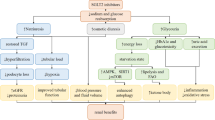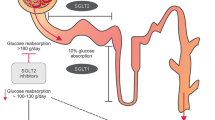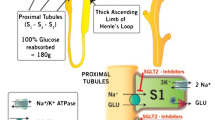Abstract
Type 2 diabetes mellitus (DM2) is a chronic condition that affects more than 400 million individuals worldwide. In DM2 patients, an appropriate glycemic control slows the onset and delays the progression of all its micro and macrovascular complications. Even though there are several glucose-lowering drugs, only approximately half of patients achieve glycemic control, while undesirable adverse effects (e.g., low serum glucose) normally affect treatment. Therefore, there is a need for new types of treatments. Sodium-glucose cotransporter 2 inhibitors (SGLT2i) have just been developed for treating DM2. Renal hyperfiltration as a marker of increased intraglomerular pressure in diabetic patients, and the role of renin–angiotensin–aldosterone system (RAAS) in this phenomenon have been studied. Nevertheless, RAAS blockade does not completely reduce hyperfiltration or diabetic renal damage. In this sense, the contribution of renal tubular factors to the hyperfiltration state, including sodium–glucose cotransporter (SGLT), has been currently studied. SGLT2i reduce proximal tubular sodium reabsorption, therefore increasing distal sodium delivery to the macula densa, causing tubule-glomerular feedback activation, afferent vasoconstriction, and reduced hyperfiltration in animal models. In humans, SGLT2i was recently shown to reduce hyperfiltration in normotensive, normoalbuminuric patients suffering from type 1 diabetes mellitus. In DM2 clinical trials, SGLT2 is associated with significant hyperfiltration and albuminuria reduction. The aim of this article is to compile the information regarding SGLT2i drugs, emphasizing its mechanism of renal repercussion.


Similar content being viewed by others
References
Halimi S, Vergès B (2014) Adverse effects and safety of SGLT-2 inhibitors. Diabetes Metab. 40(6 Suppl 1):S28–S34. https://doi.org/10.1016/S1262-3636(14)72693-X
World Health Organization [Internet] (2018) https://www.who.int/news-room/fact-sheets/detail/diabetes. Accessed 28 Aug 2018
Škrtić M, Cherney D (2015) Sodium–glucose cotransporter-2 inhibition and the potential for renal protection in diabetic nephropathy. Curr Opin Nephrol Hypertens 24(1):96–103
Poudel R (2013) Renal glucose handling in diabetes and sodium glucose cotransporter 2 inhibition. Indian J Endocrinol Metab 17(4):588–593
Gerich JE (2010) Role of the kidney in normal glucose homeostasis and in the hyperglycaemia of diabetes mellitus: therapeutic implications. Diabet Med 27(2):136–142
Salvatore T, Carbonara O, Cozzolino D, Torella R, Nasti R, Lascar N, Sasso FC (2011) Kidney in diabetes: from organ damage target to therapeutic target. Curr Drug Metab 12(7):658–666. https://doi.org/10.2174/138920011796504509
Van Bommel E, Muskiet M, Tonneijck L, Kramer M, Nieuwdorp M, van Raalte D (2017) SGLT2 Inhibition in the diabetic kidney—from mechanisms to clinical outcome. Clin J Am Soc Nephrol. 12(4):700–710
Komala MG, Panchapakesan U, Pollock C, Mather A (2013) Sodium glucose cotransporter 2 and the diabetic kidney. Curr Opin Nephrol Hypertens 22(1):113–119
De Nicola L, Gabbai F, Liberti ME, Sagliocca A, Conte G, Minutolo R (2014) Sodium/glucose cotransporter 2 inhibitors and prevention of diabetic nephropathy: targeting the renal tubule in diabetes. Am J Kidney Dis 64(1):16–24
Gómez-Fernández P, Fernández-García D (2016) Renal safety profile of sodium-glucose type 2 cotransporter inhibitors and other safety data. Med Clin (Barc). 147(Suppl 1):44–48. https://doi.org/10.1016/S0025-7753(17)30625-5
Vallon V, Thomson S (2016) Targeting renal glucose reabsorption to treat hyperglycaemia: the pleiotropic effects of SGLT2 inhibition. Diabetologia 60(2):215–225
Ferrannini E, Solini A (2012) SGLT2 inhibition in diabetes mellitus: rationale and clinical prospects. Nat Rev Endocrinol 8(8):495–502
Tejedor-Jorge A (2016) Implicaciones hemodinámicas y renales de los inhibidores del cotransportador sodio-glucosa tipo 2 en el contexto de la diabetes mellitus tipo 2. Med Clín 147(S1):35–43. https://doi.org/10.1016/S0025-7753(17)30624-3
Rajasekeran H, Cherney D, Lovshin JA (2017) Do effects of sodium–glucose cotransporter-2 inhibitors in patients with diabetes give insight into potential use in non-diabetic kidney disease? Curr Opin Nephrol Hypertens 26(5):358–367
Ferrannini E (2017) Sodium-glucose co-transporters and their inhibition: clinical physiology. Cell Metab 26(1):27–38
Panchapakesan U, Pegg K, Gross S, Komala M, Mudaliar H, Forbes J, Mather A (2013) Effects of SGLT2 inhibition in human kidney proximal tubular cells-renoprotection in diabetic nephropathy? PLoS One 8(2):e54442
Cherney D, Perkins B (2014) Sodium-glucose cotransporter 2 inhibition in type 1 diabetes: simultaneous glucose lowering and renal protection? Can J Diabetes. 38(5):356–363
Ferrannini E, Veltkamp S, Smulders R, Kadokura T (2013) Renal glucose handling: impact of chronic kidney disease and sodium-glucose cotransporter 2 inhibition in patients with type 2 diabetes. Diabetes Care 36(5):1260–1265
Jaikumkao K, Pongchaidecha A, Chatsudthipong V, Chattipakorn S, Chattipakorn N, Lungkaphin A (2017) The roles of sodium-glucose cotransporter 2 inhibitors in preventing kidney injury in diabetes. Biomed Pharmacother 94:176–187
Osorio H, Coronel I, Arellano A, Pacheco U, Bautista R, Franco M, Escalante B (2012) Sodium-glucose cotransporter inhibition prevents oxidative stress in the kidney of diabetic rats. Oxid Med Cell Longev 2012:542042. https://doi.org/10.1155/2012/542042
Wanner C (2017).EMPA-REG OUTCOME: the nephrologist’s point of view. 120(1S):S59–S67. https://doi.org/10.1016/j.amjcard.2017.05.012
Heerspink H, Kosiborod M, Inzucchi S, Cherney D (2018) Renoprotective effects of sodium-glucose cotransporter-2 inhibitors. Kidney Int 94(1):26–39
Brady JA, Hallow KM (2018) Model-based evaluation of proximal sodium reabsorption through SGLT2 in health and diabetes and the effect of inhibition with canagliflozin. J Clin Pharmacol. 58(3):377–385. https://doi.org/10.1002/jcph.1030
Maeda S, Matsui T, Takeuchi M, Yamagishi S (2013) Sodium-glucose cotransporter 2-mediated oxidative stress augments advanced glycation end products-induced tubular cell apoptosis. Diabetes/Metab Res Rev 29(5):406–412
Goldenberg R, Berall M, Chan C, Cherney D, Lovshin J, McFarlane P, Weinstein J (2018) Managing the course of kidney disease in adults with type 2 diabetes: from the old to the new. Can J Diabetes 42(3):325–334
Cherney D, Lund S, Perkins B, Groop P, Cooper M, Kaspers S, von Eynatten M (2016) The effect of sodium glucose cotransporter 2 inhibition with empagliflozin on microalbuminuria and macroalbuminuria in patients with type 2 diabetes. Diabetologia 59(9):1860–1870
Zinman B, Wanner C, Lachin JM, Fitchett, Bluhmki E, Hantel S, Mattheus M, Devins T, Johansen OE, Woerle H, Broedl UC, Inzucchi SE (2015) Empagliflozin, cardiovascular outcomes, and mortality in type 2 diabetes. N Engl J Med. 373:2117–2128
Ingelfinger J, Rosen C (2019) Clinical credence—SGLT2 inhibitors, diabetes, and chronic kidney disease. N Engl J Med 380(24):2371–2373. https://doi.org/10.1056/NEJMe1904740
Neal B, Perkovic V, Mahaffey K, de Zeeuw D, Fulcher G, Erondu N, Shaw W, Law G, Desai M, Matthews D, Phil D (2017) Canagliflozin and Cardiovascular and Renal Events in Type 2 Diabetes. N Engl J Med 377:2097–2099. https://doi.org/10.1056/NEJMc1712572
Wiviott S, Raz I, Bonaca M, Mosenzon O, Kato E, Cahn A, Silverman M, Zelniker T, Kuder J, Murphy S, Bhatt D, Leiter L, McGuire D, Wilding J, Ruff C, Gause-Nilsson I, Fredriksson M, Johansson P, Langkilde A, Sabatine M (2019) Dapagliflozin and cardiovascular outcomes in type 2 diabetes. N Engl J Med 380:347–357. https://doi.org/10.1056/nejmoa1812389
Vallon V, Richter K, Blantz RC, Thomson S, Osswald H (1999) Glomerular hyperfiltration in experimental diabetes mellitus: potential role of tubular reabsorption. J Am Soc Nephrol 10:2569–2576
Bonnet F, Scheen AJ (2018) Effects of SGLT2 inhibitors on systemic and tissue low-grade inflammation: the potential contribution to diabetes complications and cardiovascular disease. Diabetes Metab. 44(6):457–464. https://doi.org/10.1016/j.diabet.2018.09.005
Prattichizzo F, De Nigris V, Micheloni S, Sala L, Ceriello A Increases in circulating levels of ketone bodies and cardiovascular protection with SGLT2 inhibitors: Is low-grade inflammation the neglected component. Diabetes Obes Metab 20(11): 2515–2522. https://doi.org/10.1111/dom.13488
Ashley C, Dunleavy A, Cunningham J (2019) The renal drug handbook. Taylor & Francis Group, New York
Szalat A, Perlman A, Muszkat M, Khamaisi M, Abassi Z, Heyman S (2017) Can SGLT2 inhibitors cause acute renal failure? Plausible role for altered glomerular hemodynamics and medullary hypoxia. Drug Saf 41(3):239–252
Perkovic V, Jardine MJ, Neal B, Bompoint S, Heerspink HJL, Charytan DM, Edwards R, Agarwal R, Bakris G, Bull S, Cannon CP, Capuano G, Chu PL, de Zeeuw D, Greene T, Levin A, Pollock C, Wheeler DC, Yavin Y, Zhang H, Zinman B, Meininger G, Brenner BM, Mahaffey KW (2019) Canagliflozin and renal outcomes in type 2 diabetes and nephropathy. N Engl J Med. 380(24):2295–2306. https://doi.org/10.1056/NEJMoa1811744
Prattichizzo F, La Sala L, Rydén L, Marx N, Ferrini M, Valensi P, Ceriello A (2019) Glucose-lowering therapies in patients with type 2 diabetes and cardiovascular diseases. Eur J Prev Cardiol 26(2):73–80. https://doi.org/10.1177/2047487319880040
Author information
Authors and Affiliations
Corresponding author
Ethics declarations
Conflict of Interest
All the authors declare that they have no conflict of interest.
Additional information
Publisher's Note
Springer Nature remains neutral with regard to jurisdictional claims in published maps and institutional affiliations.
Rights and permissions
About this article
Cite this article
Castañeda, A.M., Dutra-Rufato, A., Juarez, M.J. et al. Sodium-glucose cotransporter 2 inhibitors (SGLT2i): renal implications. Int Urol Nephrol 53, 291–299 (2021). https://doi.org/10.1007/s11255-020-02585-w
Received:
Accepted:
Published:
Issue Date:
DOI: https://doi.org/10.1007/s11255-020-02585-w




